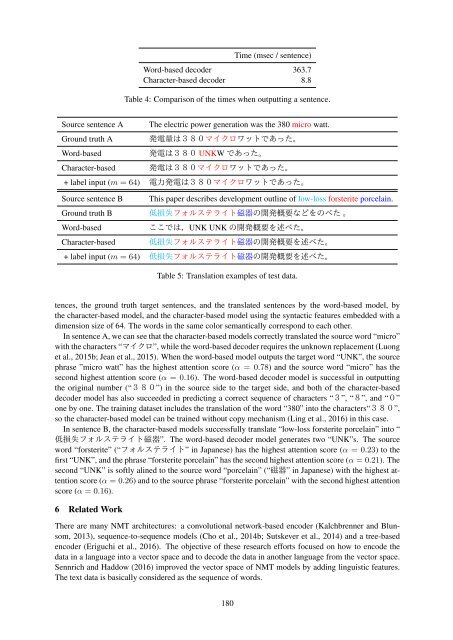December 11-16 2016 Osaka Japan
W16-46
W16-46
You also want an ePaper? Increase the reach of your titles
YUMPU automatically turns print PDFs into web optimized ePapers that Google loves.
Time (msec / sentence)<br />
Word-based decoder 363.7<br />
Character-based decoder 8.8<br />
Table 4: Comparison of the times when outputting a sentence.<br />
Source sentence A The electric power generation was the 380 micro watt.<br />
Ground truth A <br />
Word-based<br />
UNKW <br />
Character-based <br />
+ label input (m = 64) <br />
Source sentence B This paper describes development outline of low-loss forsterite porcelain.<br />
Ground truth B <br />
Word-based<br />
UNK UNK <br />
Character-based <br />
+ label input (m = 64) <br />
Table 5: Translation examples of test data.<br />
tences, the ground truth target sentences, and the translated sentences by the word-based model, by<br />
the character-based model, and the character-based model using the syntactic features embedded with a<br />
dimension size of 64. The words in the same color semantically correspond to each other.<br />
In sentence A, we can see that the character-based models correctly translated the source word “micro”<br />
with the characters “”, while the word-based decoder requires the unknown replacement (Luong<br />
et al., 2015b; Jean et al., 2015). When the word-based model outputs the target word “UNK”, the source<br />
phrase ”micro watt” has the highest attention score (α = 0.78) and the source word “micro” has the<br />
second highest attention score (α = 0.<strong>16</strong>). The word-based decoder model is successful in outputting<br />
the original number (“”) in the source side to the target side, and both of the character-based<br />
decoder model has also succeeded in predicting a correct sequence of characters “”, “”, and “”<br />
one by one. The training dataset includes the translation of the word “380” into the characters“”,<br />
so the character-based model can be trained without copy mechanism (Ling et al., 20<strong>16</strong>) in this case.<br />
In sentence B, the character-based models successfully translate “low-loss forsterite porcelain” into “<br />
”. The word-based decoder model generates two “UNK”s. The source<br />
word “forsterite” (“” in <strong>Japan</strong>ese) has the highest attention score (α = 0.23) to the<br />
first “UNK”, and the phrase “forsterite porcelain” has the second highest attention score (α = 0.21). The<br />
second “UNK” is softly alined to the source word “porcelain” (“” in <strong>Japan</strong>ese) with the highest attention<br />
score (α = 0.26) and to the source phrase “forsterite porcelain” with the second highest attention<br />
score (α = 0.<strong>16</strong>).<br />
6 Related Work<br />
There are many NMT architectures: a convolutional network-based encoder (Kalchbrenner and Blunsom,<br />
2013), sequence-to-sequence models (Cho et al., 2014b; Sutskever et al., 2014) and a tree-based<br />
encoder (Eriguchi et al., 20<strong>16</strong>). The objective of these research efforts focused on how to encode the<br />
data in a language into a vector space and to decode the data in another language from the vector space.<br />
Sennrich and Haddow (20<strong>16</strong>) improved the vector space of NMT models by adding linguistic features.<br />
The text data is basically considered as the sequence of words.<br />
180



